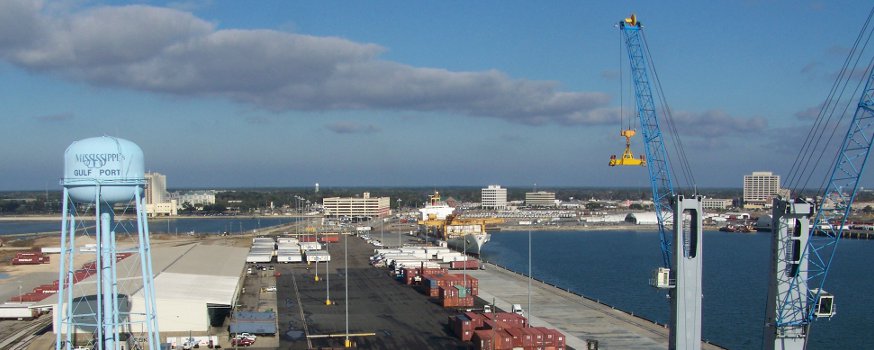
 GULFPORT, Mississippi (AP) — The state of Mississippi has spent $158.5 million on a road that does not exist.
GULFPORT, Mississippi (AP) — The state of Mississippi has spent $158.5 million on a road that does not exist.
State and county leaders began planning 22 years ago for a road to connect Interstate 10 and the state Port of Gulfport. The Mississippi Department of Transportation started spending money on the project 20 years ago after the Legislature charged the agency with the task of building the road.
The road became a vital component of port plans to dramatically increase container cargo through a $570 million expansion the federal government funded after Hurricane Katrina in 2005.
The port’s plans have changed, though. No new container-cargo tenants have signed on for the expanded port, which should be finished in 2017.
Plans for the road wound up in federal and state courts. MDOT lost. The agency is now back at square one with environmental permitting that could take years.
State budget woes also have left MDOT and other agencies with less money. The port connector will be competing with projects statewide for funding.
“We’ve kind of become a maintenance organization,” said Mark McConnell, MDOT’s chief engineer. “We’re trying to preserve what we have — our bridges and our pavement. Any kind of new construction is difficult to find the funding for.”
The money MDOT has spent on the connector road covered preliminary engineering, rights of way purchases from private property owners, utility relocation and land clearing.
McConnell estimates the state will need an additional $215 million to build the road, with only $10 million of that remaining from a previous bond issue. The state also has authority to borrow an additional $125 million for the project, leaving an unfunded balance of $80 million. McConnell stressed the cost could change because estimates would have to be updated.
Nobody on the Coast has been clamoring for the road of late. The project was controversial almost from the beginning, when MDOT decided the connector road should be elevated on the southern end, from downtown Gulfport to the port.
The city and business community lined up against an elevated connector. Royce Hignight, a retired FBI agent, delved into the project with an investigator’s eye and skills.
He wrote in the Sun Herald in August 2000: “Originally, $47.5 million was budgeted for the Port of Gulfport/Canal Road connector to I-10. MDOT’s current proposal would cost $100 million to $135 million. Now three to four years after MDOT got involved, there still is no road, and no one can even venture a guess when there might be one.
“The irony of this situation is that in 1994, the Harrison County Board of Supervisors had an engineering study done of the Canal Road/Port of Gulfport route. The study revealed that a route using existing rights of way could have been done for a total cost of $14 million.
” … This would not have been the type route that MDOT wants, but it certainly would have been a lot better than what MDOT has produced to date or has much prospect of ever producing…. This is an example of the cost the people on the Coast have paid and will continue to pay for MDOT’s incessant desire to overbuild projects which cannot be afforded.”
The need for a connector road grew more pressing when the federal government gave the Mississippi Development Authority $570 million to restore and expand the state port after Katrina as an economic development project.
The expansion has been beset by delays, but is scheduled to be completed in 2017. MDA and the port originally portrayed the expansion as creating hundreds of jobs from increased container traffic at the port. However, no new container tenants have signed up. One of three container tenants, Chiquita, is in the process of returning shipping operations to Gulfport after briefly departing for the Port of New Orleans.
Under the direction of Jonathan Daniels, the port has tapped into other markets. The port’s biggest potential tenant would be piping in gas for processing and shipment overseas, an enterprise that would add no truck or rail traffic.
Daniels said Friday the connector road would become more crucial with future expansion. The port has an environmental permit pending with the U.S. Army Corps of Engineers to add 160 acres.
“Any time you can add infrastructure that expedites traffic movement and takes it off the primary routes of the community, that is significant to improving quality of life for residents, and it’s important for future growth prospects,” Daniels said.
The port connector was for years mired in litigation — costs that are not included in MDOT’s spending total for the road. A federal judge threw out the Corps of Engineers’ environmental permit issued for the road, finding the corps acted “arbitrarily and capriciously” in issuing it.
MDOT has not filed with the Corps for another permit to move road construction forward, the Corps confirmed.
Instead, the agency is awaiting the port’s environmental study to be finished before filing its own permit with the corps, which could take years to process, depending on the proposal.
“Once the environmental process is complete,” MDOT spokesman Michael Flood said, “MDOT will have to locate funding for the project.”




Be the first to comment